
| KIT #: | |
| PRICE: | |
| DECALS: | |
| REVIEWER: | Carmel J. Attard |
| NOTES: | Conversion |

| HISTORY |
Although slow, clumsy looking and often the butt of jokes of pilots who flew the really 'hot' planes and 'old' they called it, but to many a downed airman it became a Knight in Shining armour as it rescued them from hostile waters. The consolidated Catalina is probably the most successful flying boat ever produced. The total number of Catalinas built was greater than all the flying boats combined, over 3000.
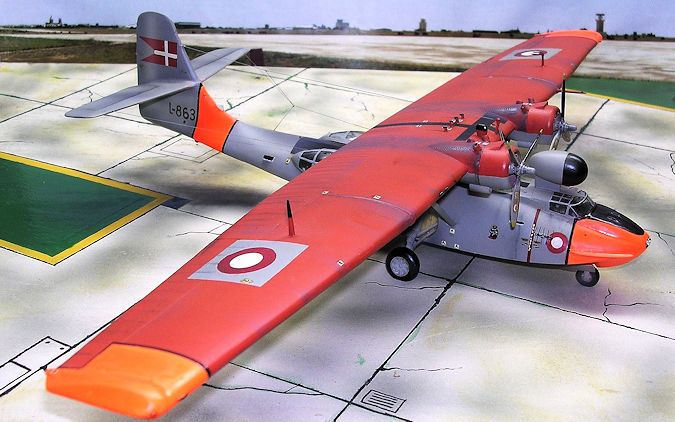 The PBY was slow but its range of 2,545 miles made it ideal for anti-shipping
patrols. Beneath its wings it could carry up to 4,000 lbs of bombs, depth
charges or torpedoes. The bulging blisters on the fuselage sides each held a .50
Cal machine gun and provided excellent visibility.
The PBY was slow but its range of 2,545 miles made it ideal for anti-shipping
patrols. Beneath its wings it could carry up to 4,000 lbs of bombs, depth
charges or torpedoes. The bulging blisters on the fuselage sides each held a .50
Cal machine gun and provided excellent visibility.
Catalinas during the war conducted night operations, harassing Japanese ships, bombing land targets, and makes open sea rescues. During night operations the flying boats would illuminate the target area by dropping parachute flares. They would then bomb and strafe the enemy supply ships etc. and also guide Navy PT boats darting in for the kill, a common method that was very effective in disrupting Japanese needed supply lines in the South Pacific.
Over 650 Catalinas were delivered to the Royal Air Force during WWII. On May 26th 1941 a Catalina located the elusive German battleship Bismark after it evaded the British naval forces which ultimately led to its sinking. Catalinas also racked up an impressive score of U-boats sinking during the war.
Following the war Catalinas remained in service with USN reserve squadrons, and also with other air forces in Europe and South Americas, while others were converted for private use. Others were adopted for use as fire bombers, able to carry 1,000 gallons of water that could be drooped on brush or forest fire. Its scoops were lowered as the sea plane skims over a lake near the fire area and can pick 960 gallons of water in only 14 seconds.
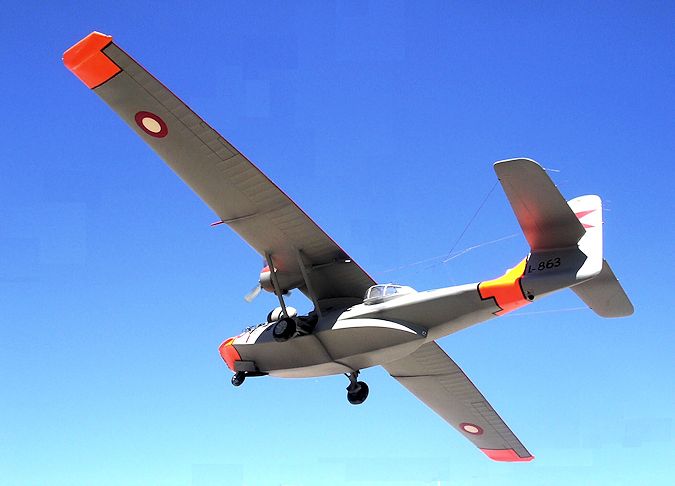 One such country that continued to use the Catalina long after the war was
Denmark, serving with the Royal Danish Air Force and was the last one to use
them. Denmark took delivery of 8 surplus USN Catalinas in 1947. At the time they
were used for aerial survey of Greenland which was started before the war. 8
more Catalinas followed in 1957 and for many years conducted yeoman service in
Greenland on air-sea rescue duties, transport duties and communications.
One such country that continued to use the Catalina long after the war was
Denmark, serving with the Royal Danish Air Force and was the last one to use
them. Denmark took delivery of 8 surplus USN Catalinas in 1947. At the time they
were used for aerial survey of Greenland which was started before the war. 8
more Catalinas followed in 1957 and for many years conducted yeoman service in
Greenland on air-sea rescue duties, transport duties and communications.
The last two PBY-5As of the original 16 delivered were still in service back in late 60s. These were based at Vaerlose transport base of the Royal Danish Air Force No 721 squadron which operated the Catalinas, eight C-47s and five C-54 Skymasters. The Catalinas still flying were L-861, 863, 866, 868 of PBY-6A batch and L-853 and 857 of PBY-5A. PBY-6A 862 and 864 were destroyed in a hangar fire and 865 crashed in a mountain. In March 1964, 867 was forced down with engine failure and although landed in the sea it became trapped in the ice and was lost.
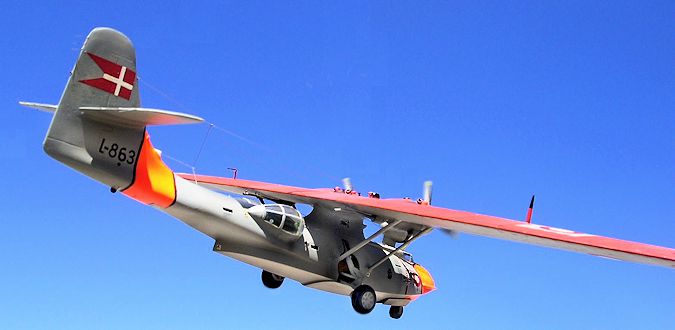 Aircraft that remained in service were skinned more than once. Danish Catalinas
also had minor modifications made to them which made them non-standard such as
radar equipment, the engines replaced with Dakota type poser plants which gave
same horse power with slight modifications on the outside mainly by adding
intake on top of cowling. Turrets were removed from nose of the aircraft and a
hatch replaced the original so that a crew member could work from them during
mooring operations. The side blister canopies on fuselage rear were retained as
these served as access to the interior for all freight and passengers.
Aircraft that remained in service were skinned more than once. Danish Catalinas
also had minor modifications made to them which made them non-standard such as
radar equipment, the engines replaced with Dakota type poser plants which gave
same horse power with slight modifications on the outside mainly by adding
intake on top of cowling. Turrets were removed from nose of the aircraft and a
hatch replaced the original so that a crew member could work from them during
mooring operations. The side blister canopies on fuselage rear were retained as
these served as access to the interior for all freight and passengers.
| THE KIT |
The Revell kit of the 'Black Cat' Catalina was used for the conversion of the
PBY-5A into the PBY-6A. Moulded in black plastic the kit of 35 years ago issue
contained optional parts to make the undercarriage
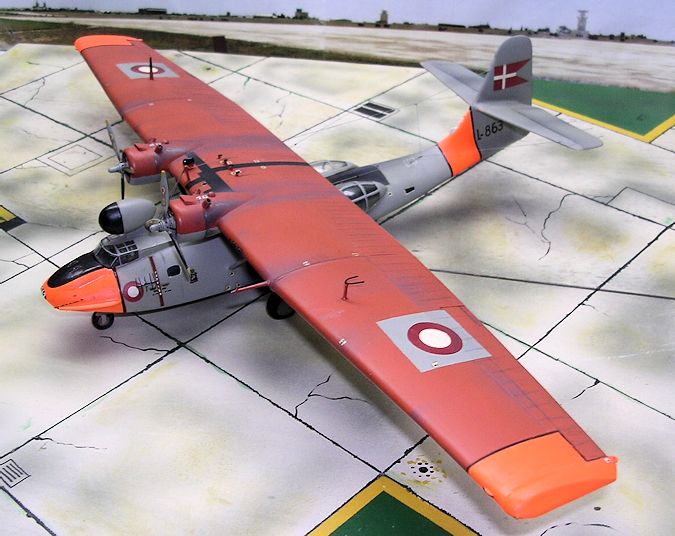 nd wing tip floats assembled
retracted or lowered form, contained fabric textured control surfaces , clear
parts on the thick side and good detail at fuselage wheel wells.
nd wing tip floats assembled
retracted or lowered form, contained fabric textured control surfaces , clear
parts on the thick side and good detail at fuselage wheel wells.
The conversion basically incorporated a revised fin and rudder, a new nose and radar a scanner behind the cockpit. Other additions included reshaping of the tail planes, additions of air intakes mounted on engine cowlings, radio aerials and a beacon position. Fuel damping pipes are also added under the wings. Most Catalinas fly with wing tip floats retracted and only extended for use on water landings and were assembled in retracted form.
Catalina conversion parts came from the Airmodel vac-form set which consisted of new tail fin and a large radome scanner. Moulded in white styrene, these were first cut and prepared as sub assemblies and which will form the replacement major items.
| CONSTRUCTION |
Making the PBY-6A involved the following extra work after the general assembly
of main kit parts followed the kit instructions and the nose turret removed and
was instead built up using plastic card and putty filler and shaped by filing
and sanding. Two hinge brackets were also added as detail to the man
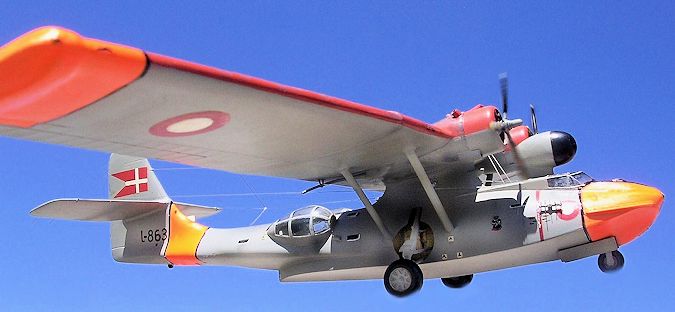 hole cover.
The long engine exhausts issued with the kit were replaced with shorter ones and
from plastic card shaped two rectangular air intakes and each added to top of
engine cowling.
hole cover.
The long engine exhausts issued with the kit were replaced with shorter ones and
from plastic card shaped two rectangular air intakes and each added to top of
engine cowling.
Two aerials were added, one a vertical and another U-shaped on top of starboard wing and on port wing respectively. Further aerials added at mid wing section and wireless joined from them to rear of fuselage. Underwing fuel dampers made from stretch sprue added. A hook added to aft fuselage used to tie fender craft at sea. A fork type antenna added to each side of nose and a mooring anchor cable added to nose area.
A large observation was cut to port nose area. A nose front window also added and two more at an area aft of side blisters at rear. An antenna made from scrap plastic was added at lower leading edge of fin and a tiny light added to mid rudder edge. The cumbersome radome fixed in place over cabin roof and wireless added from cabin roof to mid wing antenna. Add bumpers to wing leading edge close to floats and at trailing edge fixed electrostatic charge suppressors.. The nose wheel well was blanked from cockpit floor view with a piece of plastic card.
| COLORS & MARKINGS |
All wheel wells finished in zinc chromate. Areas at nose, tail unit and wing tips were airbrushed semi matt white undercoat, then day glow orange added. Fuselage finished in light aircraft gray. Top of wings painted in dull crimson red and anti glare panels and wing walkways airbrushed in satin black finish..
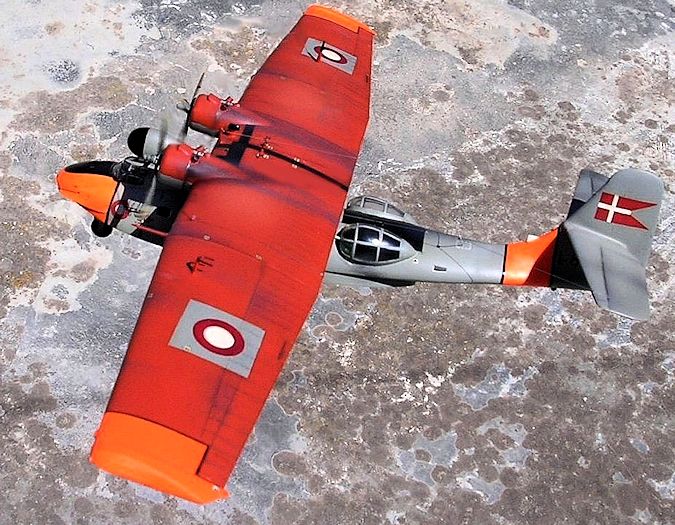 All roundels and tail flag were hand painted and serial numbers in black and
white came from spares decal box. Many tiny standard NATO code instructions were
hand painted on tiny square white decals. With all clear parts masked the model
was given a satin overall finish. Stain and exhaust areas airbrushed using fine
needle in engine gray.
All roundels and tail flag were hand painted and serial numbers in black and
white came from spares decal box. Many tiny standard NATO code instructions were
hand painted on tiny square white decals. With all clear parts masked the model
was given a satin overall finish. Stain and exhaust areas airbrushed using fine
needle in engine gray.
| CONCLUSIONS |
Converting the kit into the later version of the Catalina and assembling took a good number of hours but an almost equal time took to finish the not so simple painting of the model and making the markings for it. I should say that the small parts mostly scratch built to scale required a moderately skilled level but it is definitely within the reach of any moderately skilled modeler with a little experience with vac-forming. The finished Catalina looked just right to me sitting next to another earlier version in USCG markings.
Carmel J. Attard
August 2015 If you would like your product reviewed fairly and fairly quickly, please
contact
the editor or see other details in the
Note to
Contributors.